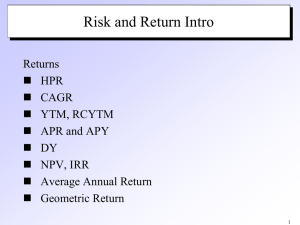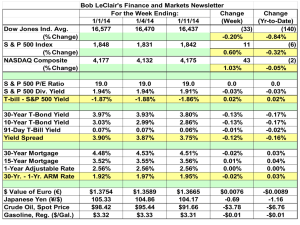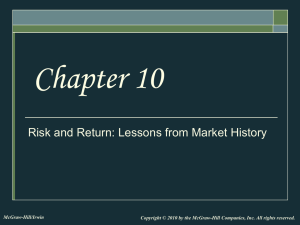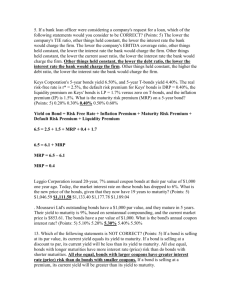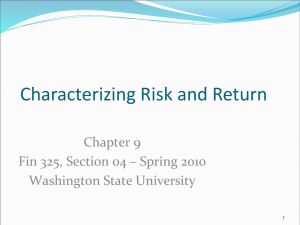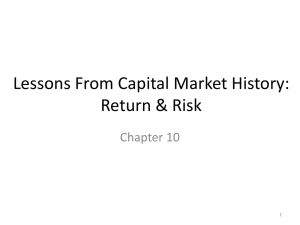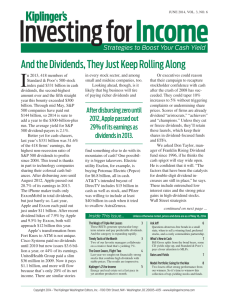Chapter 01 Quiz A
advertisement
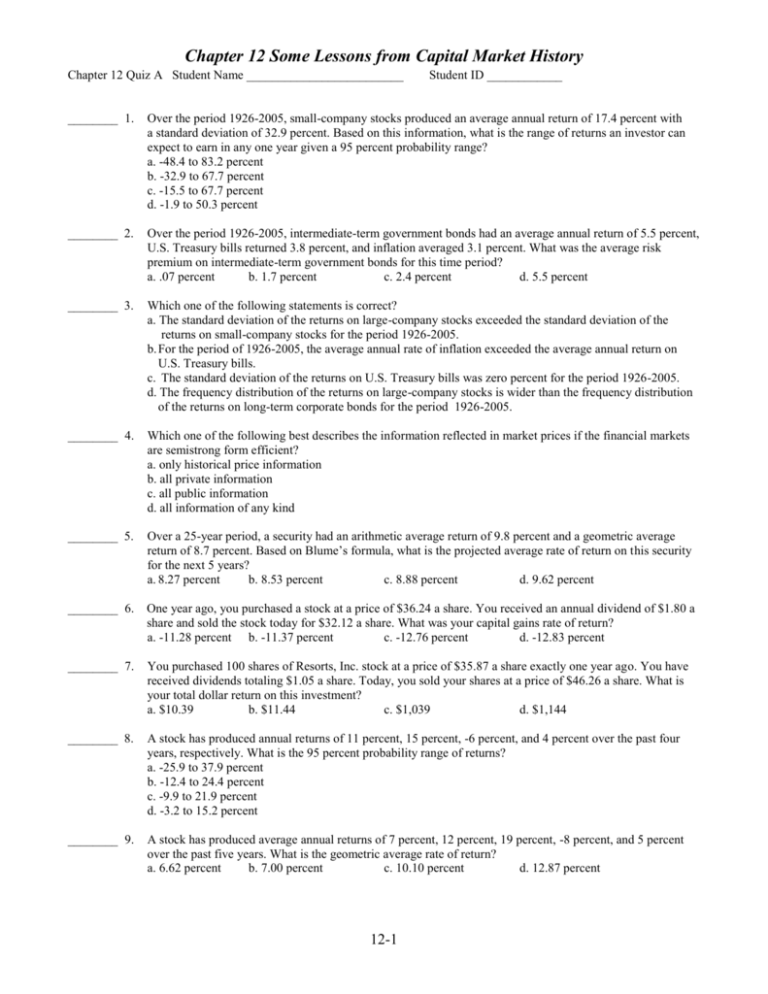
Chapter 12 Some Lessons from Capital Market History Chapter 12 Quiz A Student Name _________________________ Student ID ____________ ________ 1. Over the period 1926-2005, small-company stocks produced an average annual return of 17.4 percent with a standard deviation of 32.9 percent. Based on this information, what is the range of returns an investor can expect to earn in any one year given a 95 percent probability range? a. -48.4 to 83.2 percent b. -32.9 to 67.7 percent c. -15.5 to 67.7 percent d. -1.9 to 50.3 percent ________ 2. Over the period 1926-2005, intermediate-term government bonds had an average annual return of 5.5 percent, U.S. Treasury bills returned 3.8 percent, and inflation averaged 3.1 percent. What was the average risk premium on intermediate-term government bonds for this time period? a. .07 percent b. 1.7 percent c. 2.4 percent d. 5.5 percent ________ 3. Which one of the following statements is correct? a. The standard deviation of the returns on large-company stocks exceeded the standard deviation of the returns on small-company stocks for the period 1926-2005. b. For the period of 1926-2005, the average annual rate of inflation exceeded the average annual return on U.S. Treasury bills. c. The standard deviation of the returns on U.S. Treasury bills was zero percent for the period 1926-2005. d. The frequency distribution of the returns on large-company stocks is wider than the frequency distribution of the returns on long-term corporate bonds for the period 1926-2005. ________ 4. Which one of the following best describes the information reflected in market prices if the financial markets are semistrong form efficient? a. only historical price information b. all private information c. all public information d. all information of any kind ________ 5. Over a 25-year period, a security had an arithmetic average return of 9.8 percent and a geometric average return of 8.7 percent. Based on Blume’s formula, what is the projected average rate of return on this security for the next 5 years? a. 8.27 percent b. 8.53 percent c. 8.88 percent d. 9.62 percent ________ 6. One year ago, you purchased a stock at a price of $36.24 a share. You received an annual dividend of $1.80 a share and sold the stock today for $32.12 a share. What was your capital gains rate of return? a. -11.28 percent b. -11.37 percent c. -12.76 percent d. -12.83 percent ________ 7. You purchased 100 shares of Resorts, Inc. stock at a price of $35.87 a share exactly one year ago. You have received dividends totaling $1.05 a share. Today, you sold your shares at a price of $46.26 a share. What is your total dollar return on this investment? a. $10.39 b. $11.44 c. $1,039 d. $1,144 ________ 8. A stock has produced annual returns of 11 percent, 15 percent, -6 percent, and 4 percent over the past four years, respectively. What is the 95 percent probability range of returns? a. -25.9 to 37.9 percent b. -12.4 to 24.4 percent c. -9.9 to 21.9 percent d. -3.2 to 15.2 percent ________ 9. A stock has produced average annual returns of 7 percent, 12 percent, 19 percent, -8 percent, and 5 percent over the past five years. What is the geometric average rate of return? a. 6.62 percent b. 7.00 percent c. 10.10 percent d. 12.87 percent 12-1 Chapter 12 Some Lessons from Capital Market History ________ 10. You previously owned 200 shares of Reynolds Co. stock. This stock earned a dividend yield of 3.75 percent and a total return of 10.74 percent. If you purchased the stock at $43.90, approximately what price did you receive when you sold it one year later? a. $45.55 b. $46.97 c. $48.62 d. $50.05 12-2 Chapter 12 Some Lessons from Capital Market History Chapter 12 Quiz A Answers 1. 2. 3. 4. a b d c 95 percent probability range = 17.4 percent 2(32.9 percent) = -48.4 percent to 83.2 percent Risk premium = 5.5 percent − 3.8 percent = 1.7 percent 5. d R(5) 6. 7. 8. b d b 9. a 10. b 5 1 25 5 .087 .098 .0962 9.62 percent 25 1 25 1 Capital gains yield = ($32.12 − $36.24) / $36.24 = -.11369 = -11.37 percent ($46.26 $35.87 + $1.05) × 100 = $1,144 Average return = (.11 + .15 .06 + .04) / 4 = .06; Squared deviation = (.11 .06)2 + (.15 .06)2 + (-.06 .06)2 + (.04 .06)2 = .0025 + .0081 + .0144 + .0004 = .0254; Standard deviation = .0254 / (4 1) = .008466667 = 9.20 percent; 95 percent probability = 6.0 percent (2 × 9.20 percent) = -12.4 percent to 24.4 percent (1.07 1.12 1.19 .92 1.05).20 1 = .06617 = 6.62 percent Capital gains yield = .1075 –.0375 = .07; P2 = $43.90 (1.07) = $46.97 12-3 Chapter 12 Some Lessons from Capital Market History Chapter 12 Quiz B Student Name _________________________ Student ID ____________ ________ 1. Which one of the following is the correct formula for the capital gains yield? a. (Pt+1 − Pt + Dt) / Pt+1 b. (Pt − Pt+1 + Dt+1) / Pt+1 c. (Pt+1 − Pt) / Pt d. (Pt+1 − Pt) / Pt+1 ________ 2. Over the period 1926- 2005, large-company stocks produced an average return of 12.3 percent, inflation averaged 3.1 percent, and U.S. Treasury bills returned an average 3.8 percent. What was the average real rate of return on large-company stocks for this time period? a. 8.50 percent b. 8.92 percent c. 9.20 percent d. 9.27 percent ________ 3. Which one of the following statements is true regarding risk premiums? a. The higher the risk premium, the lower the standard deviation of the returns. b. Bonds tend to have a higher risk premium than stocks. c. Short-term bonds tend to have a higher risk premium than long-term bonds. d. U.S. Treasury bills have a zero risk premium. ________ 4. No one could benefit from inside information if the financial markets are: a. weak-form efficient. b. semi-strong form efficient. c. strong form efficient. d. either semi-strong or strong form efficient. ________ 5. Which one of the following has the widest frequency distribution of returns based on the period 1926-2005? a. long-term corporate bonds b. large-company stocks c. long-term government bonds d. small-company stocks ________ 6. You purchased 15 shares of Resorts, Inc. stock at a price of $47.87 a share exactly one year ago. You have received dividends totaling $1.35 a share. Today, you sold your shares at a price of $50.19 a share. What is your total dollar return on this investment? a. $2.32 b. $3.67 c. $34.80 d. $55.05 ________ 7. A stock has produced returns of 8 percent, 11 percent, -7 percent, and 2 percent over the past four years, respectively. What is the 95 percent probability range of returns? a. -24.0 to 31.0 percent b. -12.4 to 19.4 percent c. -10.2 to 17.2 percent d. -4.4 to 11.4 percent ________ 8. A stock has produced average annual returns of 6 percent, 8 percent, 13 percent, -1 percent, and 2 percent over the past five years, respectively. What is the geometric average rate of return? a. 4.86 percent b. 5.49 percent c. 5.55 percent d. 6.09 percent ________ 9. You previously owned 100 shares of Reynolds Co. stock. This stock earned a dividend yield of 3.55 percent and a total return of 11.65 percent. If you purchased the stock at $17.24, what price did you receive when you sold it one year later? a. $16.24 b. $17.85 c. $18.64 d. $19.25 ________ 10. One year ago, you purchased a stock at a price of $19.51 a share. You recently received an annual dividend of $0.72 a share. Today, you sold the stock for $17.93 a share. What is your dividend yield on this investment? a. -8.10 percent b. -4.80 percent c. 3.69 percent d. 4.02 percent 12-4 Chapter 12 Some Lessons from Capital Market History Chapter 12 Quiz B 1. c 2. b 3. 4. 5. 6. 7. d c d d b 8. b 9. c 10. c r Answers 1.123 1 .0892 8.92 percent 1.031 ($50.19 $47.87 + $1.35) × 15 = $55.05 Average return = (.08 + .11 .07 + .02) / 4 = 3.5 percent; Squared deviation = (.08 .035)2 + (.11 .035)2 + (-.07 .035)2 + (.02 .035)2 = .002025 + .005625 + .011025 + .000225 = .0189; Standard deviation = .0189 / (4 1) = .0063 = 7.94 percent; 95 percent probability = 3.5 percent (2 × 7.94 percent) = -12.4 percent to 19.4 percent (1.06 1.08 1.13 .99 1.02).20 1 = .05489 = 5.49 percent Capital gains yield = .1165 – .0355 = .081; P2 = $17.24 × 1.081= $18.64 Dividend yield = $0.72 / $19.51 = .0369 = 3.69 percent 12-5 Chapter 12 Some Lessons from Capital Market History Chapter 12 Quiz C Student Name _________________________ Student ID ____________ ________ 1. Which one of the following categories of securities had the most volatile returns for the period 1926-2005? a. U.S. Treasury bills b. large-company stocks c. long-term corporate bonds d. intermediate-term government bonds ________ 2. Over the period 1926-2005, small-company stocks produced an average return of 17.4 percent, inflation averaged 3.1 percent, U.S. Treasury bills returned an average 3.8 percent, and long-term corporate bonds returned 6.2 percent. What was the risk premium on small-company stocks for that period? a. 11.3 percent b. 12.4 percent c. 13.6 percent d. 14.4 percent ________ 3. Over a 45-year period, a security had an arithmetic average return of 13.6 percent and a geometric average return of 11.2 percent. Based on Blume’s formula, what is the projected average rate of return on this security for the next 10 years? a. 12.04 percent b. 12.55 percent c. 12.88 percent d. 13.11 percent ________ 4. Which form(s) of market efficiency supports the idea that market prices reflect all public but not all private information? a. weak-form b. semi-strong form c. strong form d. both weak and semi-strong forms ________ 5. Which one of the following categories produced the lowest average annual rate of return based on the historical record for the period 1926-2005? a. long-term corporate bonds b. large company stocks c. long-term government bonds d. intermediate-term government bonds ________ 6. A stock has produced average annual returns of 9 percent, 12 percent, 17 percent, -8 percent, and 3 percent over the past five years. What is the geometric average rate of return? a. 6.24 percent b. 6.67 percent c. 7.90 percent d. 9.73 percent ________ 7. You previously owned 200 shares of Reynolds Co. stock. This stock earned a dividend yield of 4.6 percent and a total return of 9.8 percent. If you purchased the stock at $30.70, what price did you receive when you sold it one year later? a. $32.11 b. $32.30 c. $33.56 d. $33.71 ________ 8. One year ago, you purchased a stock at a price of $58.62 a share. You received an annual dividend of $4.60 a share. Today, you sold this stock for $53.28 a share. What is the dividend yield on this investment? a. -9.11 percent b. 1.96 percent c. 7.85 percent d. 8.63 percent ________ 9. You purchased 5 shares of Resorts, Inc. stock at a price of $26.31 a share exactly one year ago. You have received dividends totaling $2.12 a share. Today, you sold your shares at a price of $29.47 a share. What is your total dollar return on this investment? a. $3.16 b. $5.28 c. $15.80 d. $26.40 ________ 10. A stock has produced returns of 4 percent, 10 percent, -5 percent, and 2 percent over the past four years, respectively. What is the 99 percent probability range of returns? a. -16.9 to 23.6 percent b. -15.8 to 21.3 percent c. -12.6 to 18.4 percent d. -10.7 to 15.9 percent 12-6 Chapter 12 Some Lessons from Capital Market History Chapter 12 Quiz C 1. 2. b c 3. d 4. 5. 6. 7. 8. 9. 10. b d a b c d b Answers Risk premium = 17.4 percent − 3.8 percent = 13.6 percent 10 1 45 10 R (10) .112 .136 .02291 .10818 .13109 13.11 percent 45 1 45 1 (1.09 1.12 1.17 .92 1.03).20 1 = 6.24 percent Capital gains yield = .098 – .046 = .052; P2 = $30.70 × 1.052 = $32.30 $4.60 / $58.62 = .07847 = 7.85 percent ($29.47 $26.31 + $2.12) × 5 = $26.40 Average return = (.04 + .10 .05 + .02) / 4 = 2.75 percent; Squared deviation = (.04 .0275)2 + (.10 .0275)2 + (-.05 .0275)2 + (.02 .0275)2 = .00015625 + .00525625 + .00600625 + .00005625 = .011475; Standard deviation = .011475 / (4 1) = .003825 = .061847 = 6.18 percent; 99 percent probability = 2.75 percent (3 × 6.18 percent) = -15.8 percent to 21.3 percent 12-7
